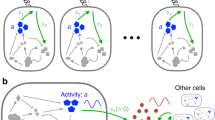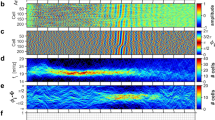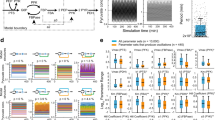Abstract
THERE is increasing evidence1–3 that the behaviour of cell populations is determined not only by the behaviour of the individual cells, but also by their mutual interactions. One influence on the strength of these interactions may be cellular proximity which, in turn, is a function of cell density. For example, myoblasts fuse only when they reach a critical cell density4. The oscillatory glycolytic metabolism of the yeast Saccharomyces carlsbergensis has provided a convenient system for the exploration of several biochemical phenomena5. For example, whereas yeast cells are generally considered to be metabolically non-interacting, a coupling process of unknown character causes metabolic synchronisation of all cells to a common oscillatory frequency and phase6. A suspension of metabolically oscillating yeast therefore behaves as a population of strongly interacting units. Because continuous monitoring of amplitude and phase by fluorometry provides a constant assay of metabolic dynamics, any perturbation of these dynamics is easily recognised as a deviation from the predictable waveform. We describe here modifications in the metabolic behaviour of intact cell suspensions achieved by manipulating the strength of their interaction through changes in cell density.
This is a preview of subscription content, access via your institution
Access options
Subscribe to this journal
Receive 51 print issues and online access
$199.00 per year
only $3.90 per issue
Buy this article
- Purchase on Springer Link
- Instant access to full article PDF
Prices may be subject to local taxes which are calculated during checkout
Similar content being viewed by others
References
Martz, E., and Steinberg, M., J. Cell Physiol., 79, 189–210 (1972).
Goldspink, G. (ed.), Differentiation and Growth in Vertebrate Tissues (Chapman and Hall, London, 1974).
DeHaan, R., and Sachs, H., Curr. Top. dev. Biol., 7, 193–228 (1972).
Konigsberg, I., Devl Biol., 26, 133–152 (1971).
Chance, B., Pye, E. K., Hess, B., and Ghosh, A. (eds), Biochemical and Biological Oscillators (Academic, New York, 1973).
Ghosh, A. K., Chance, B., and Pye, E. K., Archs Biochem. Biophys., 145, 319–331 (1971).
Pye, E. K., Can. J. Bot., 41, 271–285 (1969).
Chance, B., et al., in Biochemical and Biological Oscillators (edit. by Chance, B. Pye, E. K. Hess, B. and Ghosh, A.), 285–299 (Academic, New York, 1973).
Author information
Authors and Affiliations
Rights and permissions
About this article
Cite this article
ALDRIDGE, J., PYE, E. Cell density dependence of oscillatory metabolism. Nature 259, 670–671 (1976). https://doi.org/10.1038/259670a0
Received:
Accepted:
Issue Date:
DOI: https://doi.org/10.1038/259670a0
This article is cited by
-
Creative Agency Via Higher-Dimensional Constraints
Biosemiotics (2021)
-
Partial synchronisation of glycolytic oscillations in yeast cell populations
Scientific Reports (2020)
-
Quorum Sensing in Populations of Spatially Extended Chaotic Oscillators Coupled Indirectly via a Heterogeneous Environment
Journal of Nonlinear Science (2017)
-
Entrainment of heterogeneous glycolytic oscillations in single cells
Scientific Reports (2015)
-
Crowd synchrony in chaotic oscillators
Nonlinear Dynamics (2015)
Comments
By submitting a comment you agree to abide by our Terms and Community Guidelines. If you find something abusive or that does not comply with our terms or guidelines please flag it as inappropriate.



